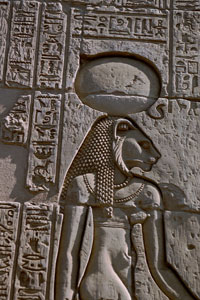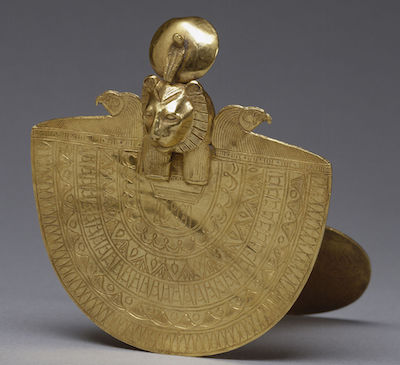
Sekhmet (Sakhmet) is one of the oldest known Egyptian deities. Her name is derived from the Egyptian word “Sekhem” (which means “power” or “might”) and is often translated as the “Powerful One” or “She who is Powerful”. She is depicted as a lion-headed woman, sometimes with the addition of a sun disc on her head.
Seated statues of Sekhmet show her holding the ankh of life, but when she is shown striding or standing she usually holds a sceptre formed from papyrus (the symbol of northern or Lower Egypt) suggesting that she was associated primarily with the north. However, some scholars argue that the deity was introduced from Sudan (South of Egypt) where lions are more plentiful.

Sekhmet was represented by the searing heat of the mid-day sun (in this aspect she was sometimes called “Nesert”, the flame) and was a terrifying goddess. However, for her friends she could avert plague and cure disease.
She was the patron of Physicians and Healers and the priests of Sekhmet became known as skilled doctors. As a result, this fearsome deity sometimes called the “lady of terror” was also known as the “lady of life”.

Sekhmet was mentioned a number of times in the spells of The Book of the Dead as both a creative and destructive force, but above all, she is the protector of Ma’at (balance or justice) named “The One Who Loves Ma’at and Who Detests Evil”.
She was also known as the “Lady of Pestilence” and the “Red Lady” (indicating her alignment with the desert) and it was thought that she could send plagues against those who angered her. When the centre of power shifted from Memphis to Thebes during the New Kingdom the Theban Triad (Amun, Mut, and Khonsu), Sekhmet’s attributes were absorbed into that of Mut (who sometimes took the form of a lion).

Sekhmet was associated with the goddesses given the title “Eye of Ra”. According to myth, Ra became angry because mankind was not following his laws and preserving Ma’at (justice or balance). He decided to punish mankind by sending an aspect of his daughter, the “Eye of Ra”. He plucked Hathor from Ureas on his brow, and sent her to earth in the form of a lion. She became Sekhmet, the “Eye of Ra” and began her rampage.

The fields ran with human blood. However, Ra was not a cruel deity, and the sight of the carnage caused him to repent. He ordered her to stop, but she was in a blood lust and would not listen. So Ra poured 7,000 jugs of beer and pomegranate juice (which stained the beer blood red) in her path. She gorged on the “blood” and became so drunk she slept for three days. When she awoke, her blood lust had dissipated, and humanity was saved.
In one version of the myth, Ptah is the first thing she sees upon awakening and she instantly falls in love with him. Their union (creation and destruction) created Nefertum (healing) and so re-established Ma’at.
The saving of mankind was commemorated every year on the feast day of Hathor/Sekhmet. Everyone drank beer stained with pomegranate juice and worshipped “the Mistress and lady of the tomb, gracious one, destroyer of rebellion, mighty one of enchantments”.

A statue of Sekhmet was dressed in red facing west, while Bast was dressed in green and faced east. Bast was sometimes considered to be Sekhmet’s counterpart (or twin depending on the legend), and in the festival of Hathor they embodied the duality central to Egyptian mythology. Sekhmet represented Upper Egypt while Bast represented Lower Egypt.
Sekhmet was closely associated with kingship. She was often described as the mother of Maahes, the lion god who was a patron of the pharaoh and the pyramid texts (from dynasty five) suggest that the pharaoh was conceived by Sekhmet. For example, one relief depicts the Pharaoh Niuserre being suckled by Sekhmet. This ancient myth is echoed in the New Kingdom reliefs in the temple of Seti I which depict the pharaoh being suckled by Hathor whose title is “mistress of the mansion of Sekhmet”.
![Sekhmet copyright Finoskov [CC BY-SA 4.0 (https://creativecommons.org/licenses/by-sa/4.0)]](https://ancientegyptonline.co.uk/wp-content/uploads/2019/06/sekhmet3.jpg)
Ramesses II (Seti’s son) adopted Sekhmet as a symbol of his power in battle. In friezes depicting the Battle of Kadesh, Sekhmet appears on his horse, her flames scorching the bodies of enemy soldiers.
One pharaoh, in particular, seems to have had an obsession of sorts with Sekhmet. Amenhotep III (father of Akhenaten, Dynasty Eighteen) built hundreds of statues of Sekhmet in the precinct of Mut’s temple (known as “Isheru”) south of the Great Temple of Amun in Karnak. It is thought that there was one for every day of the year and that offerings were made every day.
Bibliography
- Bard, Kathryn (2008) An introduction to the Archaeology of Ancient Egypt
- Goodenough, Simon (1997) Egyptian Mythology
- Kemp, Barry J (1991) Ancient Egypt: Anatomy of a Civilisation
- Lesko, Barbara S (1999) The great goddesses of Egypt
- Pinch, Geraldine (2002) Handbook Egyptian Mythology
- Redford Donald B (2002) Ancient Gods Speak
- Watterson, Barbara (1996) Gods of Ancient Egypt
- Wilkinson, Richard H. (2003) The Complete Gods and Goddesses of Ancient Egypt
- Wilkinson, Richard H. (2000) The Complete Temples of Ancient Egypt
Copyright J Hill 2008